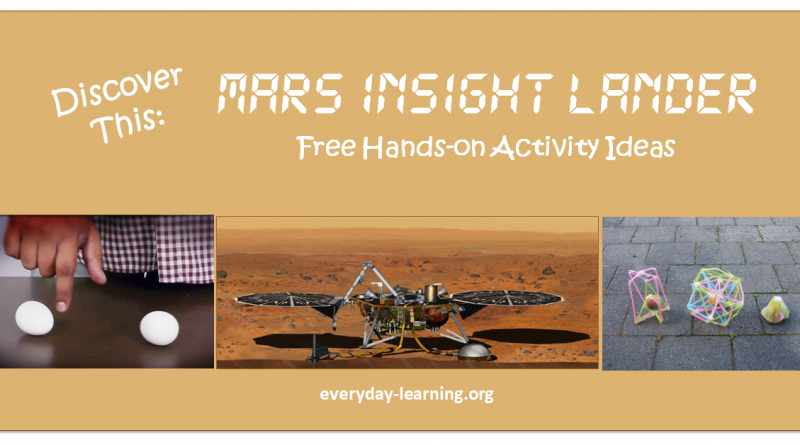Discover This The Mars Insight Lander
Discover This: The Mars Insight Lander
Just this month NASA landed a new their new InSight probe on the surface of Mars. InSight is unlike other Martain tools as we know them today. It won’t be roving around Olympus Mons or taking data of the Martian atmosphere. Instead, Insight is looking to the core in an attempt to discover why Earth is habitable, but Mars is not. While it may seem that Mars is a planet far away, it is really only 1.5 times farther from the Sun that we are. While temperature is certainly an issue in supporting life on Mars, could there be another reason why life is not present on the Red Planet?
Life on Earth relies on much more than temperature. It relies on:
- Water
- Magnetic fields
- Plate tectonics
- Planetary core, and
- Crust thickness
When you think about it, since Earth is the only planet in the universe we have ever seen life on, we can’t be sure what blend of geography, chemistry, physics, and biology are needed to create and support life on a planet. Below are some activities you can do to learn about the importance of Earth’s qualities to the life we enjoy.
Investigate solid core versus liquid core differences
One of the missions of InSight is to learn more about Mars’ core. The core of a planet determines how a planet will spin. You can see this in action by spinning a raw egg and spinning a boiled egg.
What do you notice? Which egg spins faster? Which egg wobbles less while spinning? Why do you think that is?
Visit the National Geographic free online encyclopedia or the BBC’s Geology channel to research what type of solid or liquid core Earth has. Next, see if you can postulate (a fancy word for ‘guess’) what type of core might be helpful to sustaining life. Based on your knowledge of Earth’s core type and how the matching egg spun, what can you say about the type of core Mars has?

Discover how we can now locate Mars in space
One of the InSight’s instruments, called RISE, will help scientists pinpoint – with unparalleled accuracy – the position of Mars as it moves through space. In the previous activity, you looked at to eggs spinning. This wobble can tell us about the type of core Mars has by looking at the wobble of Mars.
RISE works by emitting radio waves that are intercepted by Earth. We can detect subtle changes in the sounds of these radio waves and learn about Mars’ precise planetary movements. To get an idea of what this would be like, listen carefully next time a police car or an ambulance passes by. This is an example of something called the Doppler Effect.
As that siren passes by, what do you hear? Is the noise always the same? What does it sound like as the siren approaches you? How is the sound different if it travels away from you? Scientists plan to use the basic ideas about the Doppler Effect to determine how Mars is moving, and potentially wobbling, through space.
Try to land on Mars
NASA has been highly successful in landing their space missions on Mars because of a lot of engineering and design work by the Entry, Descent, and Landing (EDL) team. EDL, Safely landing InSight (and all of our other rovers and landers) on the surface of Mars is a difficult prospect because of Mars’ atmosphere.
Earth’s atmosphere is thick enough that we can use a heat shield to help space crafts re-enter, deploy a parachute, and then safely land on the Earth’s surface. Mars’ atmosphere is different. It is thick enough to generate a lot of heat, which requires all of our scientific space equipment to have a heat shield. After that heat shield is released, the space lander or rover can use a parachute to begin to slow down, but the atmosphere is not thick enough to actually slow it down enough to land safely. That’s why the EDL team must come up with special ways to land Mars rovers and probes so they will actually work once they’re on the surface of the red planet.
Take some time and research what scientists have used in the past to land crafts on Mars. Did InSight use a new or old technique?
- Mars Pathfinder (1996)
- Deep Space 2 (1999)
- Spirit and Opportunity (2003)
- Phoenix Mars Lander (2007)
- Mars Science Laboratory “Curiosity” (2011)
- ExoMars (2016)
Now that you learned about the multiple ways EDL teams landed on Mars, you can create your own EDL team to protect an egg from a tall drop. This project is great for all ages, as you can make it more difficult by altering the allowed materials. For example, can you protect an egg from a three-story fall with just straws? Yes. You absolutely can. But how? Get free ideas on different egg drop challenge designs.
Manned Mars Missions
NASA has been studying the effects of space travel on the human body for years. They’ve even had the opportunity to conduct research on identical twins – both of whom are NASA astronauts – when one went into space for a full year and the other twin stayed on Earth. In all the excitement to report the scientific findings, some news sources started saying that space travel mutates a person’s DNA. Read what NASA did discover about the effects of living in outer space and find out if those changes were permanent.
The Discover This Mars InSight Lander guest post was written by Dr. Erica from RosieResearch.com. With a Masters in Engineering Physics and a PhD in Molecular Biophysics, Dr. Erica’s research is currently being used by scientists to understand Jedi mind control. (Seriously, it’s a field of science called Optogenetics. Check it out.) Dr. Erica writes awesome hands-on science lessons for kids.




